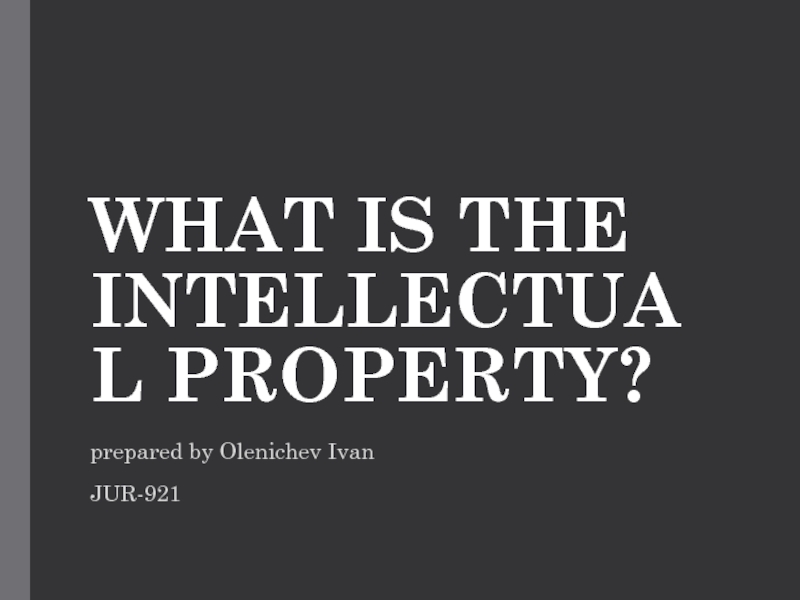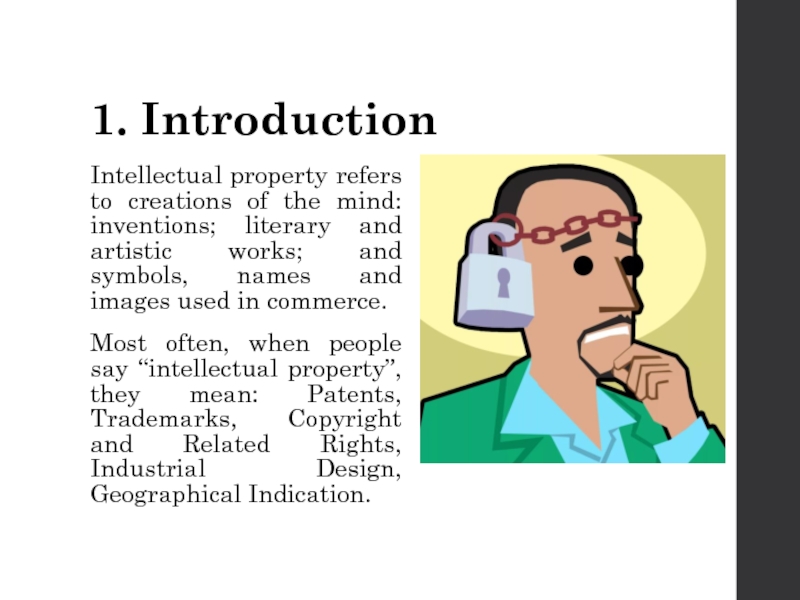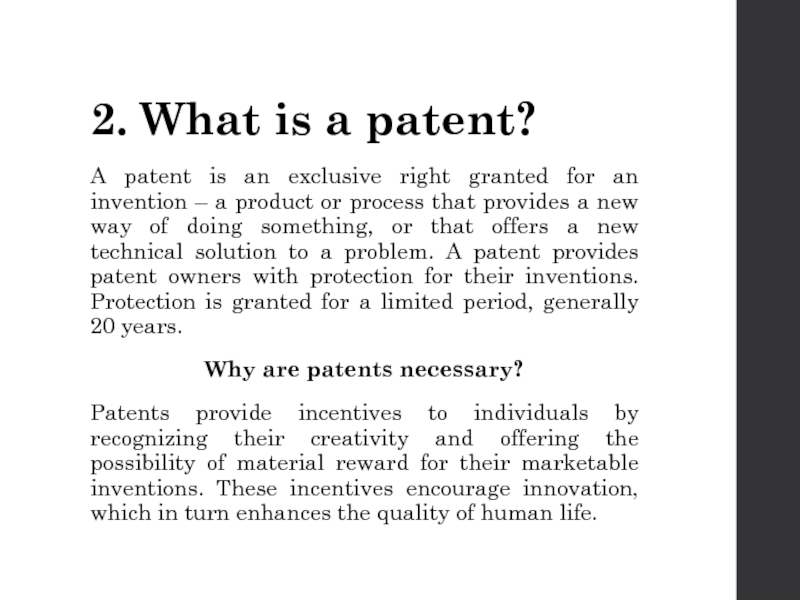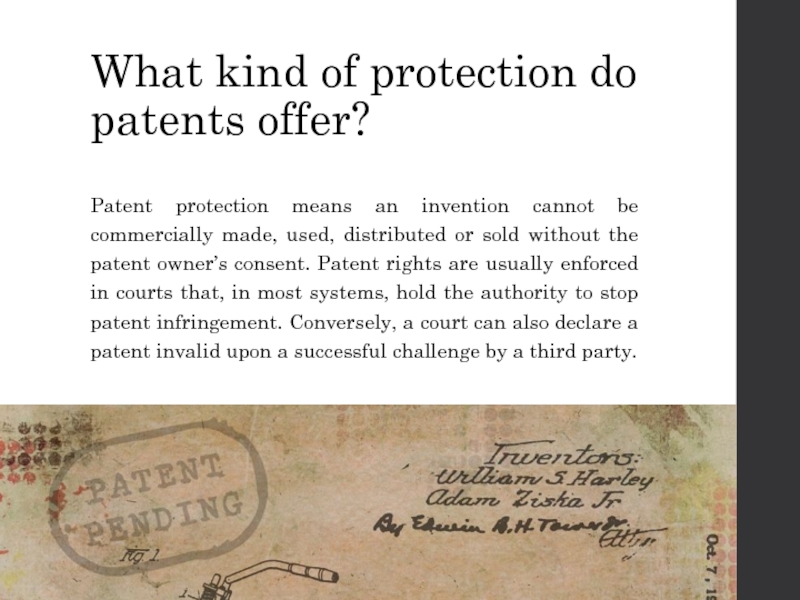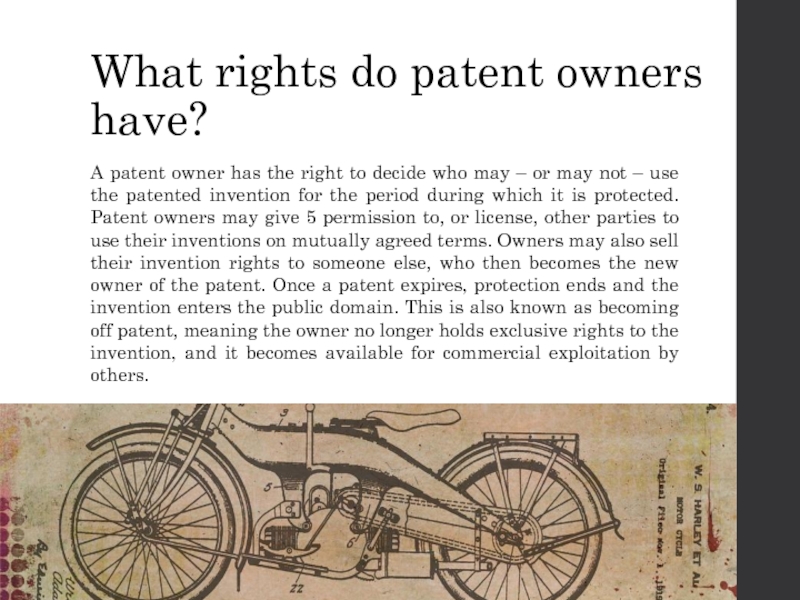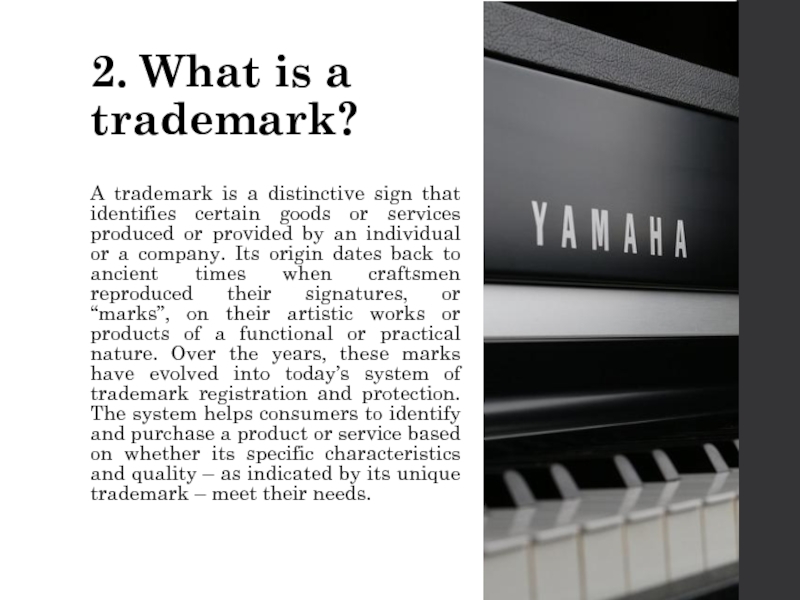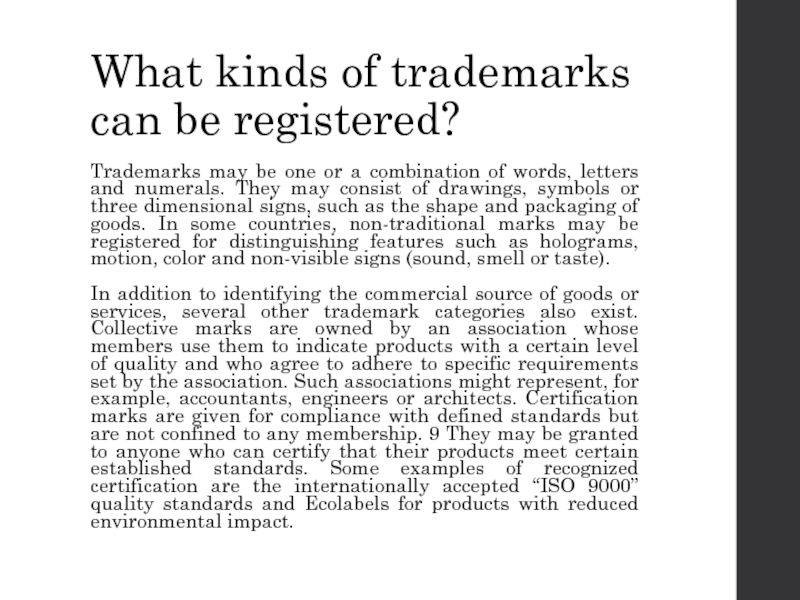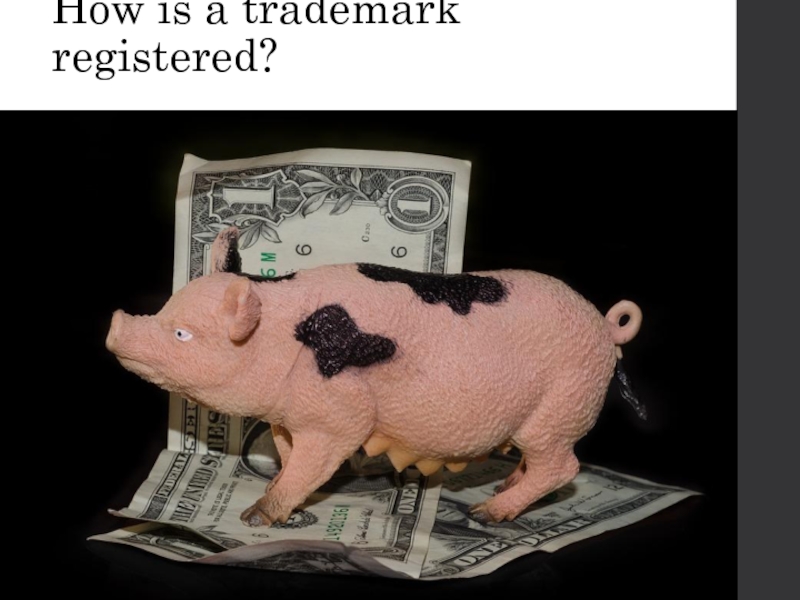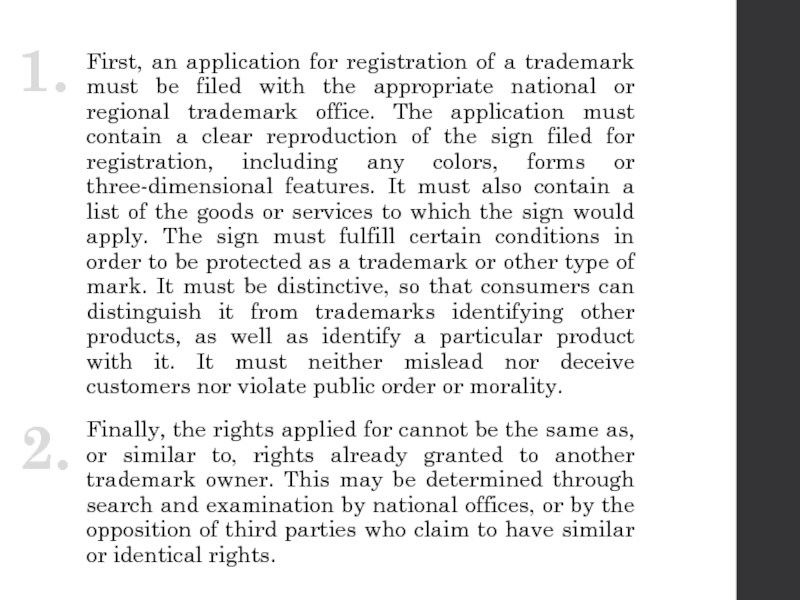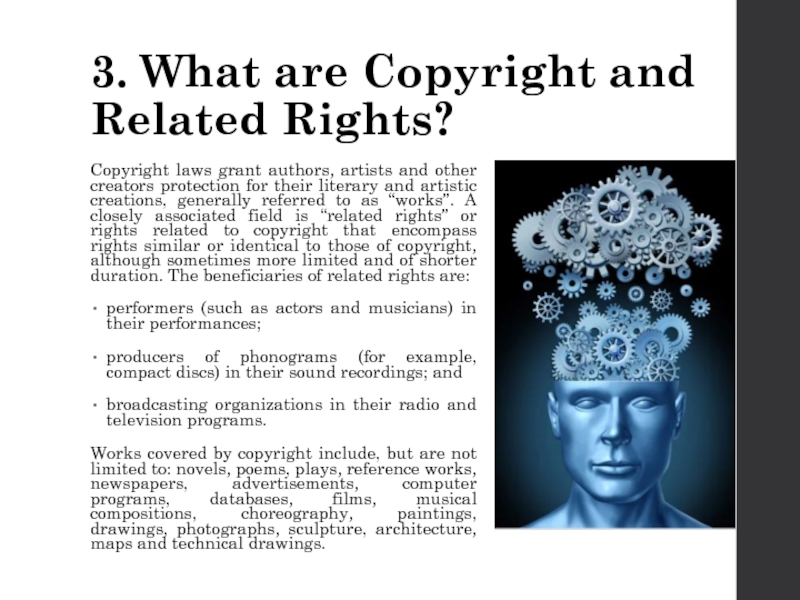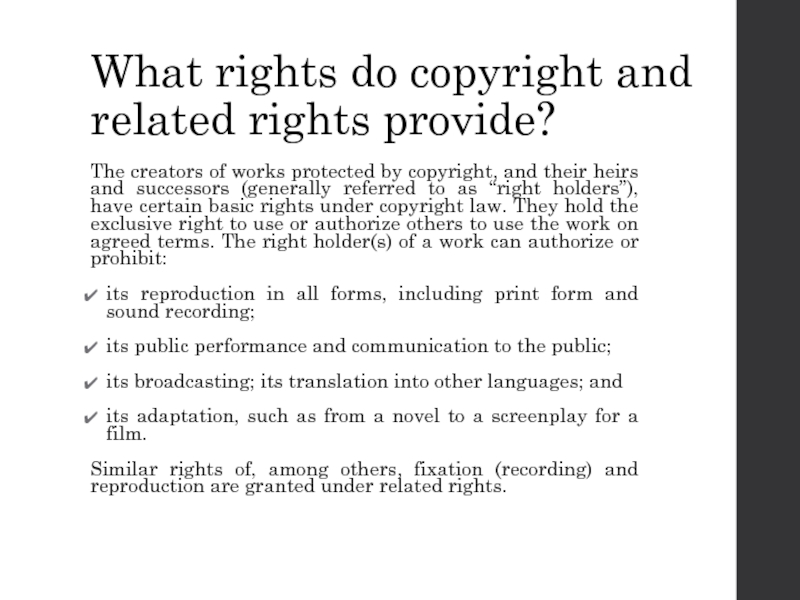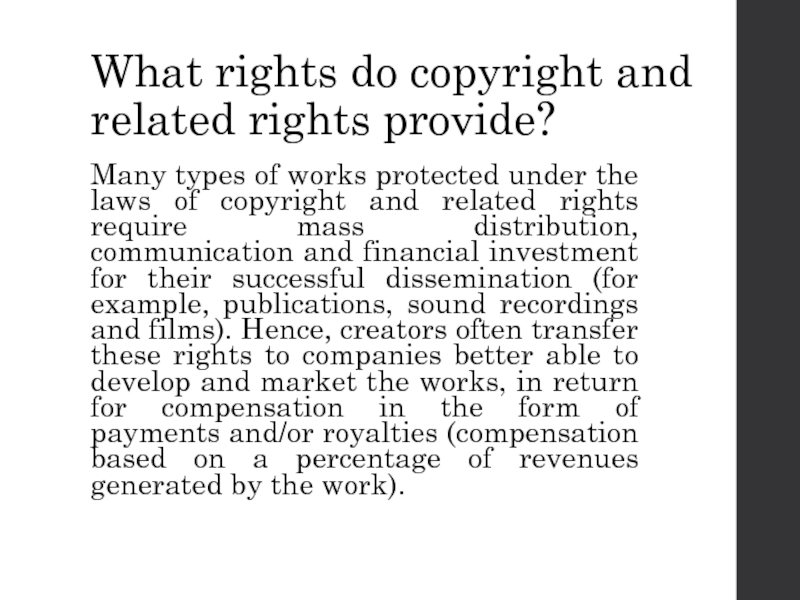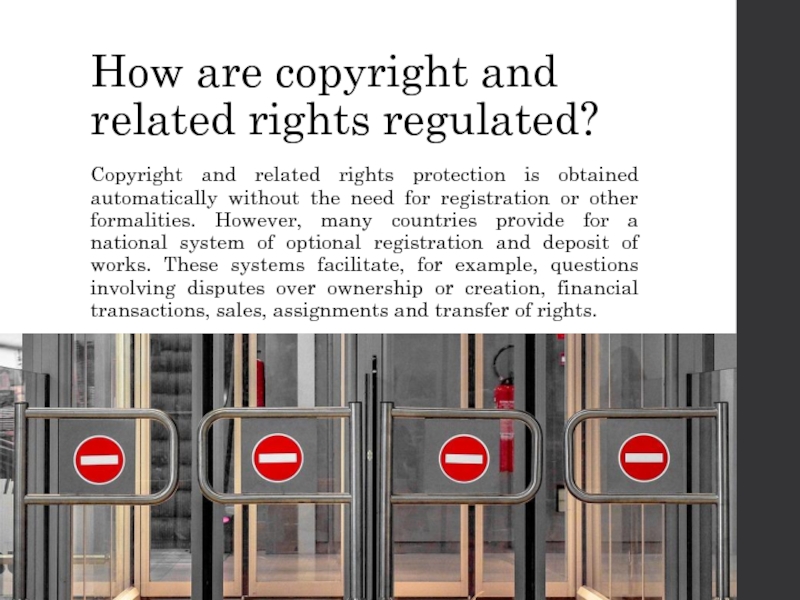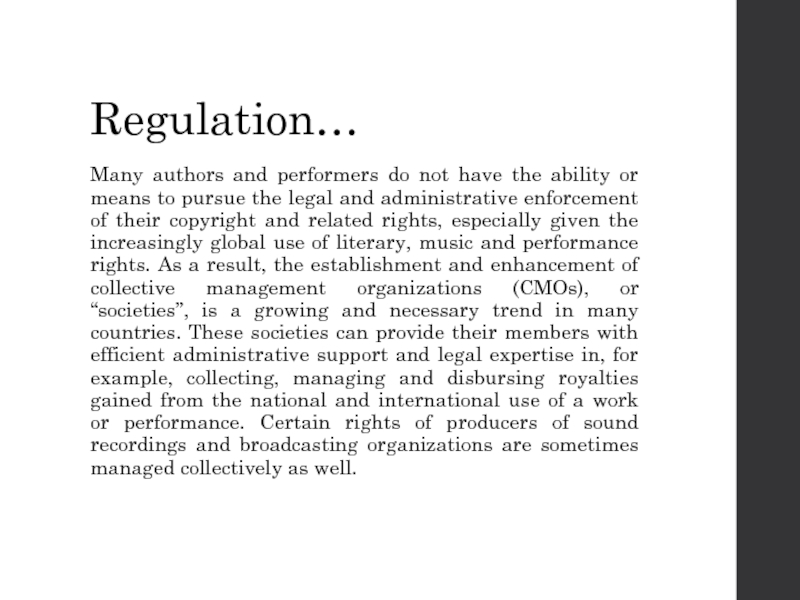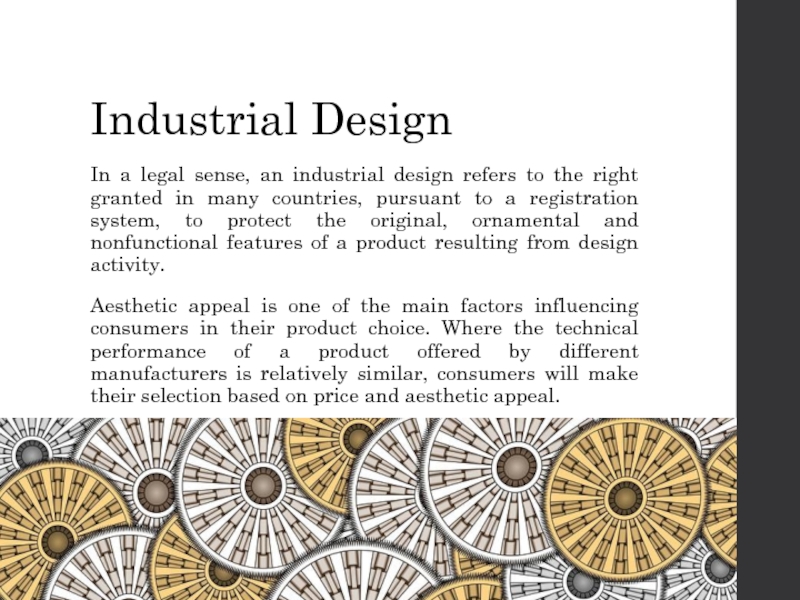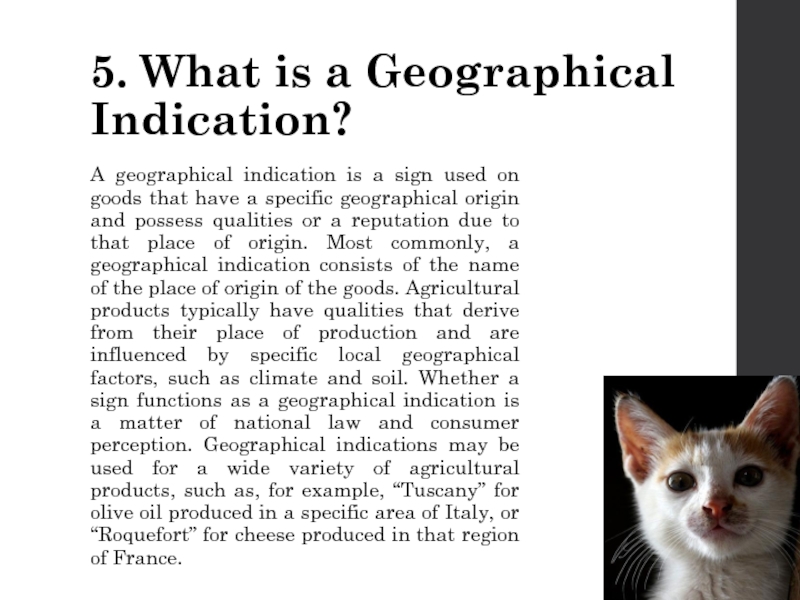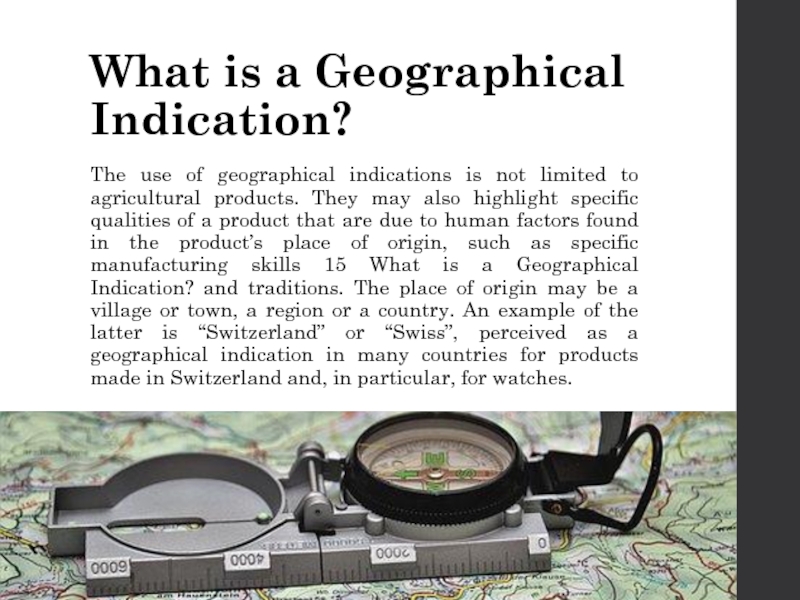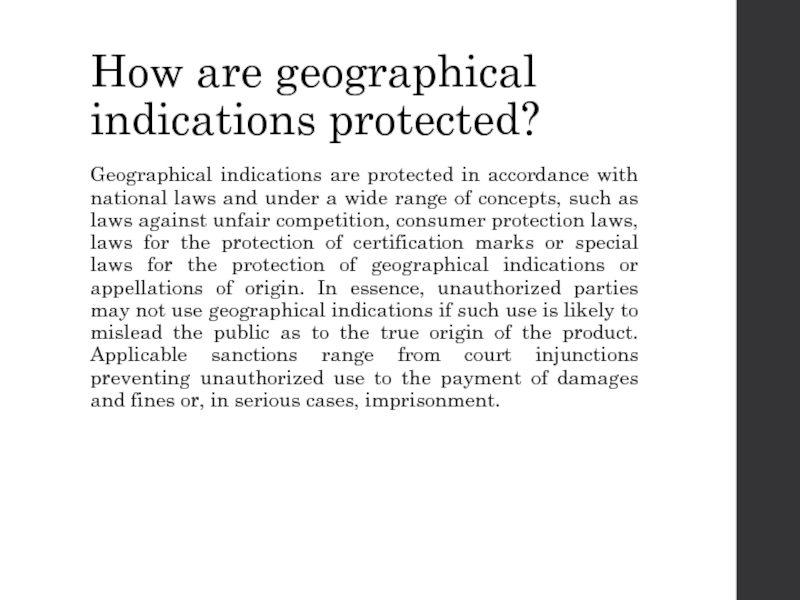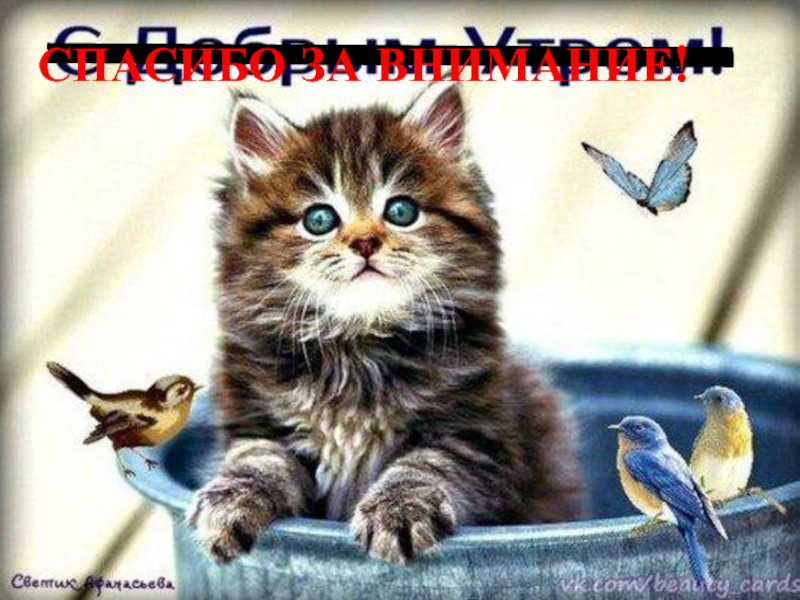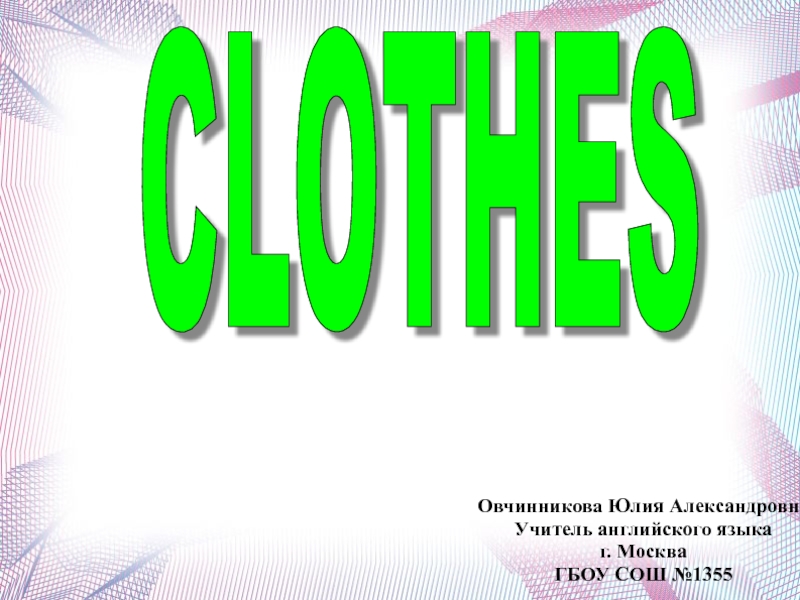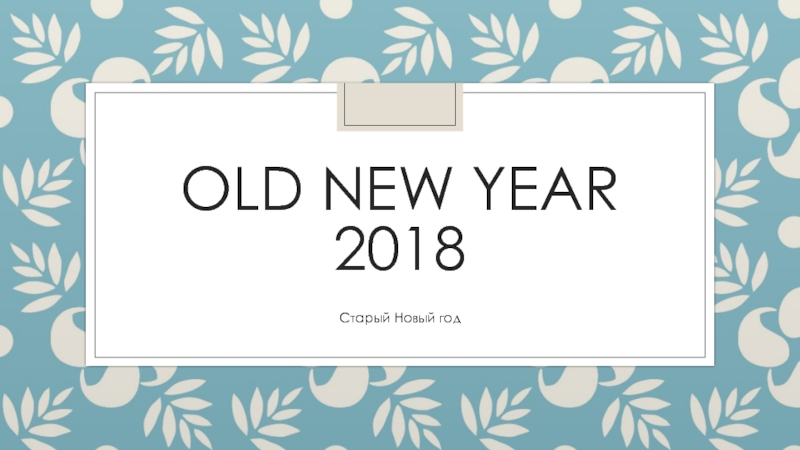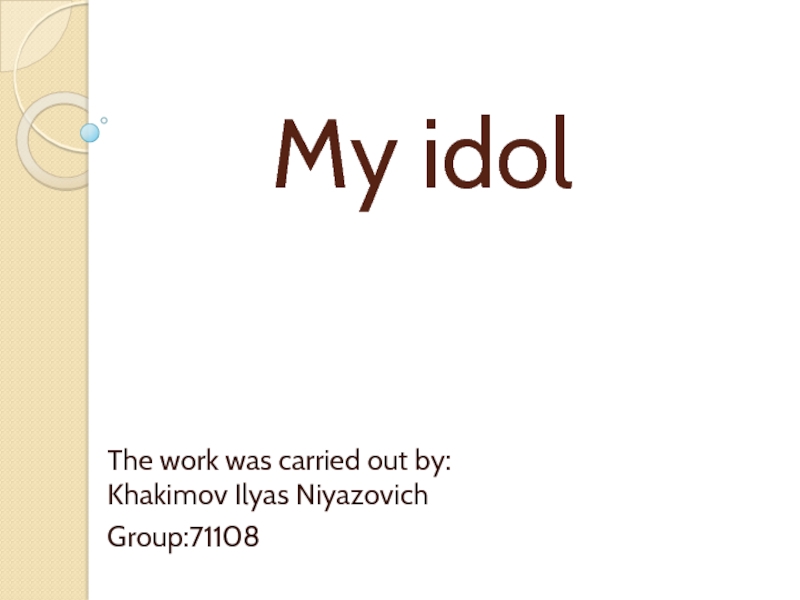- Главная
- Разное
- Дизайн
- Бизнес и предпринимательство
- Аналитика
- Образование
- Развлечения
- Красота и здоровье
- Финансы
- Государство
- Путешествия
- Спорт
- Недвижимость
- Армия
- Графика
- Культурология
- Еда и кулинария
- Лингвистика
- Английский язык
- Астрономия
- Алгебра
- Биология
- География
- Детские презентации
- Информатика
- История
- Литература
- Маркетинг
- Математика
- Медицина
- Менеджмент
- Музыка
- МХК
- Немецкий язык
- ОБЖ
- Обществознание
- Окружающий мир
- Педагогика
- Русский язык
- Технология
- Физика
- Философия
- Химия
- Шаблоны, картинки для презентаций
- Экология
- Экономика
- Юриспруденция
What is the intellectual property? презентация
Содержание
- 1. What is the intellectual property?
- 2. 1. Introduction Intellectual property refers to creations
- 3. 2. What is a patent? A patent
- 4. What kind of protection do patents offer?
- 5. What rights do patent owners have?
- 6. 2. What is a trademark?
- 7. What kinds of trademarks can be registered?
- 8. How is a trademark registered?
- 9. First, an application for registration of a
- 10. 3. What are Copyright and Related Rights?
- 11. What rights do copyright and related rights
- 12. What rights do copyright and related rights
- 13. How are copyright and related rights regulated?
- 14. Regulation… Many authors and performers do not
- 15. 4. What is an Industrial Design? Industrial
- 16. Industrial Design In a legal sense, an
- 17. How extensive is industrial design protection? Generally,
- 18. 5. What is a Geographical Indication? A
- 19. What is a Geographical Indication? The use
- 20. How are geographical indications protected? Geographical indications
- 21. СПАСИБО ЗА ВНИМАНИЕ!
Слайд 21. Introduction
Intellectual property refers to creations of the mind: inventions; literary
and artistic works; and symbols, names and images used in commerce.
Most often, when people say “intellectual property”, they mean: Patents, Trademarks, Copyright and Related Rights, Industrial Design, Geographical Indication.
Most often, when people say “intellectual property”, they mean: Patents, Trademarks, Copyright and Related Rights, Industrial Design, Geographical Indication.
Слайд 32. What is a patent?
A patent is an exclusive right granted
for an invention – a product or process that provides a new way of doing something, or that offers a new technical solution to a problem. A patent provides patent owners with protection for their inventions. Protection is granted for a limited period, generally 20 years.
Why are patents necessary?
Patents provide incentives to individuals by recognizing their creativity and offering the possibility of material reward for their marketable inventions. These incentives encourage innovation, which in turn enhances the quality of human life.
Why are patents necessary?
Patents provide incentives to individuals by recognizing their creativity and offering the possibility of material reward for their marketable inventions. These incentives encourage innovation, which in turn enhances the quality of human life.
Слайд 4What kind of protection do patents offer?
Patent protection means an
invention cannot be commercially made, used, distributed or sold without the patent owner’s consent. Patent rights are usually enforced in courts that, in most systems, hold the authority to stop patent infringement. Conversely, a court can also declare a patent invalid upon a successful challenge by a third party.
Слайд 5What rights do patent owners have?
A patent owner has the
right to decide who may – or may not – use the patented invention for the period during which it is protected. Patent owners may give 5 permission to, or license, other parties to use their inventions on mutually agreed terms. Owners may also sell their invention rights to someone else, who then becomes the new owner of the patent. Once a patent expires, protection ends and the invention enters the public domain. This is also known as becoming off patent, meaning the owner no longer holds exclusive rights to the invention, and it becomes available for commercial exploitation by others.
Слайд 62. What is a
trademark?
A trademark is a distinctive sign
that identifies certain goods or services produced or provided by an individual or a company. Its origin dates back to ancient times when craftsmen reproduced their signatures, or “marks”, on their artistic works or products of a functional or practical nature. Over the years, these marks have evolved into today’s system of trademark registration and protection. The system helps consumers to identify and purchase a product or service based on whether its specific characteristics and quality – as indicated by its unique trademark – meet their needs.
Слайд 7What kinds of trademarks can be registered?
Trademarks may be one
or a combination of words, letters and numerals. They may consist of drawings, symbols or three dimensional signs, such as the shape and packaging of goods. In some countries, non-traditional marks may be registered for distinguishing features such as holograms, motion, color and non-visible signs (sound, smell or taste).
In addition to identifying the commercial source of goods or services, several other trademark categories also exist. Collective marks are owned by an association whose members use them to indicate products with a certain level of quality and who agree to adhere to specific requirements set by the association. Such associations might represent, for example, accountants, engineers or architects. Certification marks are given for compliance with defined standards but are not confined to any membership. 9 They may be granted to anyone who can certify that their products meet certain established standards. Some examples of recognized certification are the internationally accepted “ISO 9000” quality standards and Ecolabels for products with reduced environmental impact.
In addition to identifying the commercial source of goods or services, several other trademark categories also exist. Collective marks are owned by an association whose members use them to indicate products with a certain level of quality and who agree to adhere to specific requirements set by the association. Such associations might represent, for example, accountants, engineers or architects. Certification marks are given for compliance with defined standards but are not confined to any membership. 9 They may be granted to anyone who can certify that their products meet certain established standards. Some examples of recognized certification are the internationally accepted “ISO 9000” quality standards and Ecolabels for products with reduced environmental impact.
Слайд 9First, an application for registration of a trademark must be filed
with the appropriate national or regional trademark office. The application must contain a clear reproduction of the sign filed for registration, including any colors, forms or three-dimensional features. It must also contain a list of the goods or services to which the sign would apply. The sign must fulfill certain conditions in order to be protected as a trademark or other type of mark. It must be distinctive, so that consumers can distinguish it from trademarks identifying other products, as well as identify a particular product with it. It must neither mislead nor deceive customers nor violate public order or morality.
Finally, the rights applied for cannot be the same as, or similar to, rights already granted to another trademark owner. This may be determined through search and examination by national offices, or by the opposition of third parties who claim to have similar or identical rights.
Finally, the rights applied for cannot be the same as, or similar to, rights already granted to another trademark owner. This may be determined through search and examination by national offices, or by the opposition of third parties who claim to have similar or identical rights.
1.
2.
Слайд 103. What are Copyright and Related Rights?
Copyright laws grant authors, artists
and other creators protection for their literary and artistic creations, generally referred to as “works”. A closely associated field is “related rights” or rights related to copyright that encompass rights similar or identical to those of copyright, although sometimes more limited and of shorter duration. The beneficiaries of related rights are:
performers (such as actors and musicians) in their performances;
producers of phonograms (for example, compact discs) in their sound recordings; and
broadcasting organizations in their radio and television programs.
Works covered by copyright include, but are not limited to: novels, poems, plays, reference works, newspapers, advertisements, computer programs, databases, films, musical compositions, choreography, paintings, drawings, photographs, sculpture, architecture, maps and technical drawings.
performers (such as actors and musicians) in their performances;
producers of phonograms (for example, compact discs) in their sound recordings; and
broadcasting organizations in their radio and television programs.
Works covered by copyright include, but are not limited to: novels, poems, plays, reference works, newspapers, advertisements, computer programs, databases, films, musical compositions, choreography, paintings, drawings, photographs, sculpture, architecture, maps and technical drawings.
Слайд 11What rights do copyright and related rights provide?
The creators of works
protected by copyright, and their heirs and successors (generally referred to as “right holders”), have certain basic rights under copyright law. They hold the exclusive right to use or authorize others to use the work on agreed terms. The right holder(s) of a work can authorize or prohibit:
its reproduction in all forms, including print form and sound recording;
its public performance and communication to the public;
its broadcasting; its translation into other languages; and
its adaptation, such as from a novel to a screenplay for a film.
Similar rights of, among others, fixation (recording) and reproduction are granted under related rights.
its reproduction in all forms, including print form and sound recording;
its public performance and communication to the public;
its broadcasting; its translation into other languages; and
its adaptation, such as from a novel to a screenplay for a film.
Similar rights of, among others, fixation (recording) and reproduction are granted under related rights.
Слайд 12What rights do copyright and related rights provide?
Many types of works
protected under the laws of copyright and related rights require mass distribution, communication and financial investment for their successful dissemination (for example, publications, sound recordings and films). Hence, creators often transfer these rights to companies better able to develop and market the works, in return for compensation in the form of payments and/or royalties (compensation based on a percentage of revenues generated by the work).
Слайд 13How are copyright and related rights regulated?
Copyright and related rights protection
is obtained automatically without the need for registration or other formalities. However, many countries provide for a national system of optional registration and deposit of works. These systems facilitate, for example, questions involving disputes over ownership or creation, financial transactions, sales, assignments and transfer of rights.
Слайд 14Regulation…
Many authors and performers do not have the ability or means
to pursue the legal and administrative enforcement of their copyright and related rights, especially given the increasingly global use of literary, music and performance rights. As a result, the establishment and enhancement of collective management organizations (CMOs), or “societies”, is a growing and necessary trend in many countries. These societies can provide their members with efficient administrative support and legal expertise in, for example, collecting, managing and disbursing royalties gained from the national and international use of a work or performance. Certain rights of producers of sound recordings and broadcasting organizations are sometimes managed collectively as well.
Слайд 154. What is an Industrial Design?
Industrial designs are applied to a
wide variety of industrial products and handicrafts. They refer to the ornamental or aesthetic aspects of an article, including compositions of lines or colors or any three-dimensional forms that give a special appearance to a product or handicraft. The design must have aesthetic appeal. Moreover, it must be able to be reproduced by industrial means; this is the essential purpose of the design and the reason the design is called “industrial”.
Слайд 16Industrial Design
In a legal sense, an industrial design refers to the
right granted in many countries, pursuant to a registration system, to protect the original, ornamental and nonfunctional features of a product resulting from design activity.
Aesthetic appeal is one of the main factors influencing consumers in their product choice. Where the technical performance of a product offered by different manufacturers is relatively similar, consumers will make their selection based on price and aesthetic appeal.
Aesthetic appeal is one of the main factors influencing consumers in their product choice. Where the technical performance of a product offered by different manufacturers is relatively similar, consumers will make their selection based on price and aesthetic appeal.
Слайд 17How extensive is industrial design protection?
Generally, industrial design protection is limited
to the country in which protection is granted. The Hague Agreement Concerning the International Registration of Industrial Designs, a WIPO administered treaty, offers a procedure for international registration of designs. Applicants can file a single international application either with WIPO or the national or regional office of a country party to the treaty. The design will then be protected in as many member countries of the treaty as the applicant designates.
Слайд 185. What is a Geographical Indication?
A geographical indication is a sign
used on goods that have a specific geographical origin and possess qualities or a reputation due to that place of origin. Most commonly, a geographical indication consists of the name of the place of origin of the goods. Agricultural products typically have qualities that derive from their place of production and are influenced by specific local geographical factors, such as climate and soil. Whether a sign functions as a geographical indication is a matter of national law and consumer perception. Geographical indications may be used for a wide variety of agricultural products, such as, for example, “Tuscany” for olive oil produced in a specific area of Italy, or “Roquefort” for cheese produced in that region of France.
Слайд 19What is a Geographical Indication?
The use of geographical indications is not
limited to agricultural products. They may also highlight specific qualities of a product that are due to human factors found in the product’s place of origin, such as specific manufacturing skills 15 What is a Geographical Indication? and traditions. The place of origin may be a village or town, a region or a country. An example of the latter is “Switzerland” or “Swiss”, perceived as a geographical indication in many countries for products made in Switzerland and, in particular, for watches.
Слайд 20How are geographical indications protected?
Geographical indications are protected in accordance with
national laws and under a wide range of concepts, such as laws against unfair competition, consumer protection laws, laws for the protection of certification marks or special laws for the protection of geographical indications or appellations of origin. In essence, unauthorized parties may not use geographical indications if such use is likely to mislead the public as to the true origin of the product. Applicable sanctions range from court injunctions preventing unauthorized use to the payment of damages and fines or, in serious cases, imprisonment.
